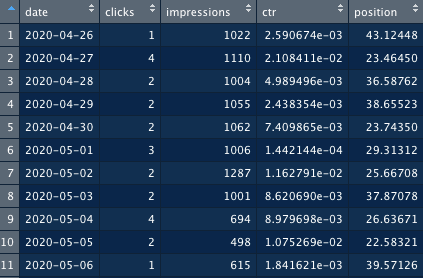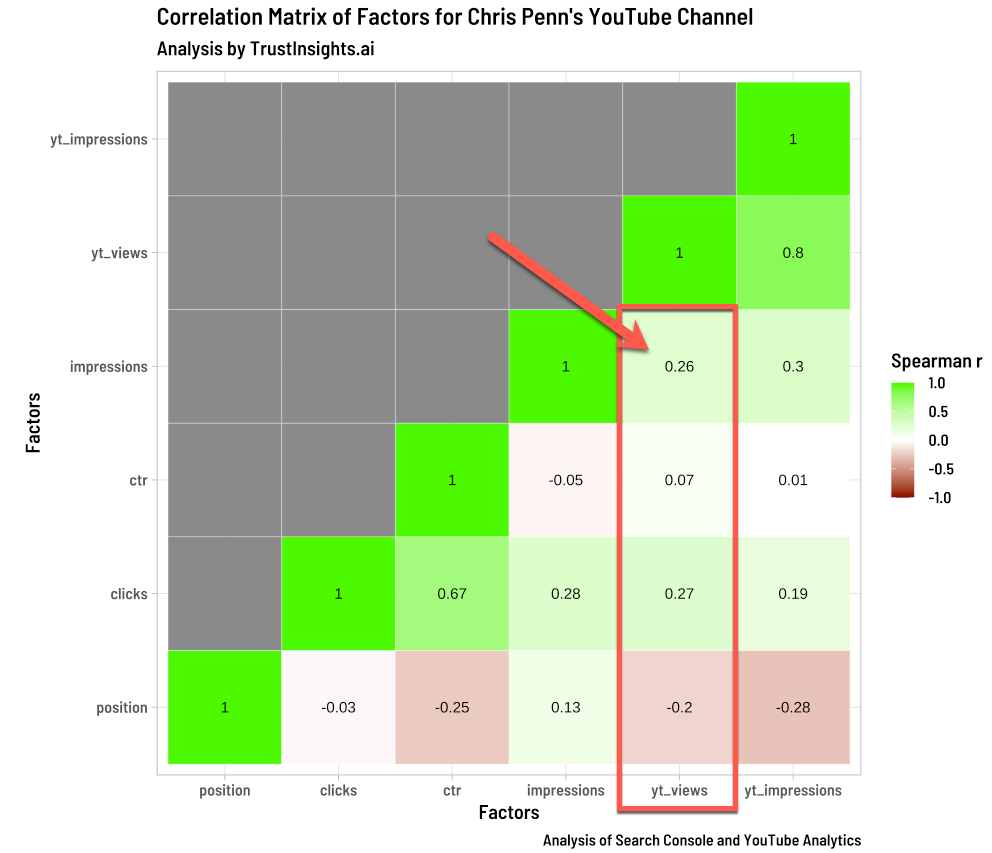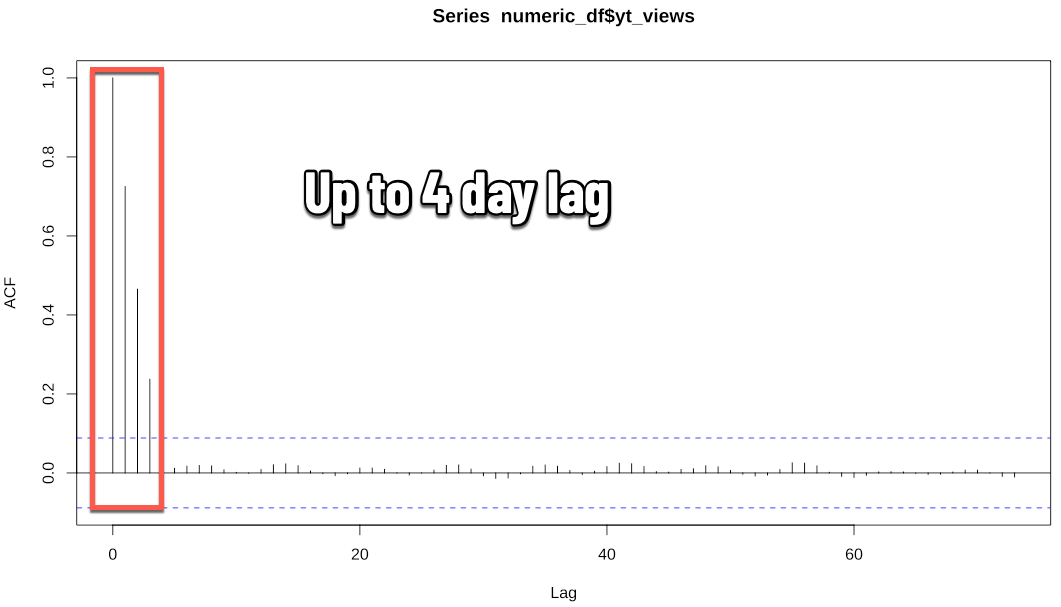INBOX INSIGHTS: What Do You Do, YouTube Impact on Brand, B2B Marketing Strategy (9/8)
We’re hiring for an Account Manager! »
What Do You Do Versus What Do You Do for Me?
My family and friends often ask, “What does Trust Insights do?” and for some reason, I struggle to come up with a simple answer. Why? Because I’m trying to answer “what we do” instead of “what we do for you”. I muddle through phrases like “change management” and “machine learning”. Outside of Trust Insights, those words don’t mean anything.
Before I get into that, let me take a step back in time to about…oh, three hours ago. I’ve worked with Chris Penn long enough he’s rarely able to blow my mind with information. Today was that day. Earlier while recording our weekly podcast we were talking about marketing metrics. As we do, we got off on a tangent that was related but not the original intention of the conversation. Chris brought up the example of his morning YouTube show “You Ask, I Answer” that he did for about a year or so. When he applied the metrics we were talking about, he determined that the show itself wasn’t producing conversions – so he stopped making it. I countered by asking if the show was part of the larger marketing plan and was it driving awareness? Was it assisting other channels that were converting?
This led us into a conversation around a study that Chris recently read from LinkedIn around buyer’s intent. In a nutshell, 95% of your audience is not interested in buying something right now. You can listen to the podcast to hear my mind being blown in real-time.
This flipped my world upside down in the best of ways. It made me rethink how we were approaching our own marketing for Trust Insights. We don’t need to focus on the hard sell, we need to make sure we’re teaching and educating on what we do so that when someone has a problem, we’re top of mind. “Trust Insights can solve that problem for me”.
Which brings me back to the original question, “What does Trust Insights do?”
We solve problems. Pretty vague? Yea – that’s why we need to drill down to “what does Trust Insights do for me?” We solve your specific marketing problems.
What this means is that our content needs to focus on demonstrating our problem-solving skills. We need to understand the specific problems of our network. We need to show that we know how to solve those specific problems.
A lot of the problems we solve focus on marketing platforms. What Chris and I need to do is talk about the issues as they relate not only to the data and tech, but also the people and processes involved. We need to bring more specificity into our content so that you, the reader, can see yourself in the narrative. The goal is to show that we not only solve general problems but also your specific problems. If we do this correctly, we should be top of mind when you happen to have an issue that you need help with.
All this is a long-winded way of saying that Chris and I do a lot of things for clients, but at the end of the day, we’re fixers. I’ll skip the frameworks and the jargon. You can get that from our website. Instead, I’ll leave you with the immortal words of Robert Matthew Van Winkle:
“If you got a problem yo I’ll solve it”
Tell me about the problems you’re solving so I can write about them! Find me in our free Slack group Analytics for Marketers.
– Katie Robbert, CEO

Do you have a colleague or friend who needs this newsletter? Send them this link to help them get their own copy:
https://www.trustinsights.ai/newsletter

In this episode of In-Ear Insights, Katie and Chris discuss the alphabet soup of some common marketing metrics – CPM, CPC, CPA, ROAS, ROI, and CLV – what they mean, when they apply, and how to interpret them. How do you organize these metrics to tell a coherent story about the customer experience, and what insights can we glean from them? The episode finishes with an exploration of how metrics may not be mapped to correct objectives, especially for B2B marketing strategy. Tune in for all the details!
Watch/listen to this episode of In-Ear Insights here »
Last week on So What? The Marketing Analytics and Insights Live Show, we dug into email marketing metrics and analytics – what to pay attention to, and what upcoming privacy changes mean. Tune in!
Watch/listen to this episode of So What? here »
This Thursday at 1 PM Eastern, we’ll be doing a guided tour of Google’s Postmaster Tools, one of the most important tools for any email marketer to know well.
Are you following our YouTube channel? If not, click/tap here to follow us!
Need a reminder?

Trust Insights is hiring!
We’re specifically hiring for a part-time Account Manager, someone who can weave the complex magic that is balancing client needs, company needs, and keeping as many people happy as practical. This is a remote, work from anywhere with good Internet access position for an independent contractor.
For full details, check out our Careers page listing »
Interested in sponsoring INBOX INSIGHTS? Contact us for sponsorship options to reach over 18,000 analytically-minded marketers and business professionals every week.

In this week’s Data Diaries, let’s try answering the question that came up in this week’s podcast episode: was there ANY effect on brand from the daily video show I used to do? Answering questions like this is key to attribution analysis, but many attribution analysis methods focus solely on the outcomes at the bottom of the funnel. What if, as Katie and I chatted about, YouTube content doesn’t directly impact the bottom of the funnel because of the nature of B2B marketing? What if it does impact my personal brand instead?
To answer this question, we’d need to be able to measure the strength of my brand. One of the best metrics for measuring brand strength is branded organic search; if no one’s searching for you, your company, or your products/services by name, you don’t have much brand strength because no one remembers you when they sit down to search.
Google Search Console allows you to download up to 16 months of data; since my show stopped on December 10, 2020, we’ve got plenty of data from both before and after. We’ll want to filter by brand terms; since this is my personal website and Search Console data, I’ll filter by my name and the name of my blog. Let’s see what the data looks like:

Search Console gives us these data points:
- Clicks: how many people clicked on a search result
- Impressions: how many times your site showed up in search results
- CTR: the rate of Clicks / Impressions
- Position: what relative position in search ranking the site came up in search results
For this exploration, we’ll focus on impressions; if no one’s typing your brand into search to begin with, there won’t be any impressions at all.
Next, we’ll export data from YouTube itself for every video by date, along with impressions:

YouTube impressions are the number of times your videos are shown as thumbnails in search results, recommendations, or in your feed/channel. Views are the number of times a video of yours was viewed for at least 30 seconds.
Let’s first merge these two sets of data by date and do a correlation analysis. Is there ANY relationship between YouTube views and Search Console impressions?

The short answer is yes, there is, but it’s not very strong – a Spearman R of 0.26. In most correlation analyses, 0 – 0.25 is no correlation, 0.25 – 0.5 is a weak correlation, and above 0.5 is a strong correlation. It’s strong enough, however, that we should keep digging.
One of the challenges of dealing with data that has time involved – data with dates – is that correlations can break if there’s a lag of some kind. If your YouTube video is watched one day, and someone searches for you the next day, mathematically there’s zero correlation – but we know behaviorally there’s a real relationship there. Fortunately, that’s something statistical software can test with a technique called autocorrelation:

What we see is that YouTube video views and search impressions DO have a relationship – a fairly strong one – but it’s spread out over 4 days. In other words, someone viewing an episode of my show might take up to 4 days to go search for me by name. That time lag indeed does mess up our correlation analysis above.
So, here’s the big money question: does producing the show have any impact on my personal brand? To find the answer to this, we’ll employ a technique called propensity modeling which is widely used in biological sciences and medicine. Essentially, doing something is the “treatment”, and we want to compare similar days when the treatment was occurring versus days when the treatment was not occurring to see if it had any impact. We have a fairly balanced data set – about 8 months of data from when my show was happening, and 8 months of data when it wasn’t happening. The length of the dataset overcomes that 4 day lag. Let’s see what the potential impact of the show was:

Column 2 is when my show was running. Column 3 is when my show wasn’t running. What conclusions can we draw?
- YouTube views were up 110% when the show was running. Logical – more content = more views.
- YouTube impressions were up 52% when the show was running. Also logical – more content = more opportunities for YouTube’s recommendation engine to do its thing.
- The money, such as it is, is in search console impressions. When the show was running, I had 10% more branded search impressions than when the show wasn’t running.
Is that important? Is 10% a good number? In my attribution analysis, organic search consistently drives nearly 50% of my conversions. In August of 2021, that was 145 conversions (things like newsletter signups, book sales, etc.). The YouTube show could, in other words, add another 14-15 conversions. I’d need to think about whether the tradeoff of time invested is worth those conversions, but you can imagine if there were bigger dollar stakes involved than things like book purchases, 14-15 conversions could be a very big deal.
The key takeaway from all this is that the question of a marketing activity’s impact on brand is knowable to some extent, enough to make a decision with your data. It’s not perfect; we could write an entire additional newsletter issue on some of the data limitations, but it IS good enough. I’d encourage you to use these same techniques to answer questions you have about your activities; this particular set of techniques is excellent for analyzing any marketing activity that has defined start and stop periods (as opposed to “always on” marketing).

Here’s some of our content from recent days that you might have missed.
- Spring Cleaning your Marketing Data
- Marketing Analytics, Data Science and Leadership September 6th, 2021 Week In Review
- Google Analytics since the first days of the company
- {PODCAST} In-Ear Insights: Marketing Strategy and MarTech Stack Drift
- So What? Analyzing Your Email Marketing Performance

Get skilled up with an assortment of our free, on-demand classes.
- How to Deliver Reports and Prove the ROI of your Agency
- Next-Level Twitter Analytics
- Proving Social Media ROI
- Competitive Social Media Analytics Strategy
- What Works on Instagram: A Data-Driven Study
- Predictive Analytics and Customer Experience

This is a roundup of the best content you and others have written and shared in the last week.
Data Science and AI
- 9 AI Tools For Media Creation
- How to Organize Data Labeling for Machine Learning: Practical Approaches via insideBIGDATA
- Machine Learning Is A Critical Element of Modern SMS Marketing
SEO, Google, and Paid Media
- Critical Analytics That Will Improve Your SEO Results
- How to Improve Your SEO by Identifying Low-Hanging-Fruit Keywords
- 46 SEO Job Interview Questions to Assess a Candidates Knowledge
Social Media Marketing
- How to Use TikTok for B2B Marketing & Who’s Doing It Right
- 9 Types of Social Media and How Each Can Benefit Your Business
- Facebook Tests New Ad Automation Flows to Help Maximize Campaign Performance via Social Media Today
Content Marketing
- How to Create a B2B Content Strategy
- When We Blame the Intern, We Demonstrate Weak Leadership Spin Sucks
- Why Content Links Are So Naturally Rare (and What to Do About It) via ReadWrite

Are you a member of our free Slack group, Analytics for Marketers? Join 1900+ like-minded marketers who care about data and measuring their success. Membership is free – join today. Members also receive sneak peeks of upcoming data, credible third-party studies we find and like, and much more. Join today!

Where can you find us in person?
- MAICON, September 2021, virtual, use TRUSTINSIGHT20 for 20% off your ticket
- MarTech Conference, September 2021, virtual
- Content Marketing World, September 2021, virtual
- MarketingProfs B2B Forum, October 2021, virtual
Going to a conference we should know about? Reach out!
Want some private training at your company? Ask us!

First and most obvious – if you want to talk to us about something specific, especially something we can help with, hit up our contact form.
Where do you spend your time online? Chances are, we’re there too, and would enjoy sharing with you. Here’s where we are – see you there?
- Our blog
- Slack
- YouTube
- In-Ear Insights on Apple Podcasts
- In-Ear Insights on Google Podcasts
- In-Ear Insights on all other podcasting software

Our Featured Partners are companies we work with and promote because we love their stuff. If you’ve ever wondered how we do what we do behind the scenes, chances are we use the tools and skills of one of our partners to do it.
- Hubspot CRM
- StackAdapt Display Advertising
- Agorapulse Social Media Publishing
- WP Engine WordPress Hosting
- Techsmith Camtasia and Snagit Media Editing
- Talkwalker Media Monitoring
- Marketmuse Professional SEO software
- Gravity Forms WordPress Website Forms
- Otter AI transcription
- Semrush Search Engine Marketing
- Our recommended media production gear on Amazon
Read our disclosures statement for more details, but we’re also compensated by our partners if you buy something through us.

Some events and partners have purchased sponsorships in this newsletter and as a result, Trust Insights receives financial compensation for promoting them. Read our full disclosures statement on our website.

Thanks for subscribing and supporting us. Let us know if you want to see something different or have any feedback for us!
|
Need help with your marketing AI and analytics? |
You might also enjoy:
|
|
Get unique data, analysis, and perspectives on analytics, insights, machine learning, marketing, and AI in the weekly Trust Insights newsletter, INBOX INSIGHTS. Subscribe now for free; new issues every Wednesday! |
Want to learn more about data, analytics, and insights? Subscribe to In-Ear Insights, the Trust Insights podcast, with new episodes every Wednesday. |
Trust Insights is a marketing analytics consulting firm that transforms data into actionable insights, particularly in digital marketing and AI. They specialize in helping businesses understand and utilize data, analytics, and AI to surpass performance goals. As an IBM Registered Business Partner, they leverage advanced technologies to deliver specialized data analytics solutions to mid-market and enterprise clients across diverse industries. Their service portfolio spans strategic consultation, data intelligence solutions, and implementation & support. Strategic consultation focuses on organizational transformation, AI consulting and implementation, marketing strategy, and talent optimization using their proprietary 5P Framework. Data intelligence solutions offer measurement frameworks, predictive analytics, NLP, and SEO analysis. Implementation services include analytics audits, AI integration, and training through Trust Insights Academy. Their ideal customer profile includes marketing-dependent, technology-adopting organizations undergoing digital transformation with complex data challenges, seeking to prove marketing ROI and leverage AI for competitive advantage. Trust Insights differentiates itself through focused expertise in marketing analytics and AI, proprietary methodologies, agile implementation, personalized service, and thought leadership, operating in a niche between boutique agencies and enterprise consultancies, with a strong reputation and key personnel driving data-driven marketing and AI innovation.










One thought on “INBOX INSIGHTS, September 8, 2021: What Do You Do, YouTube Impact on Brand, B2B Marketing Strategy”